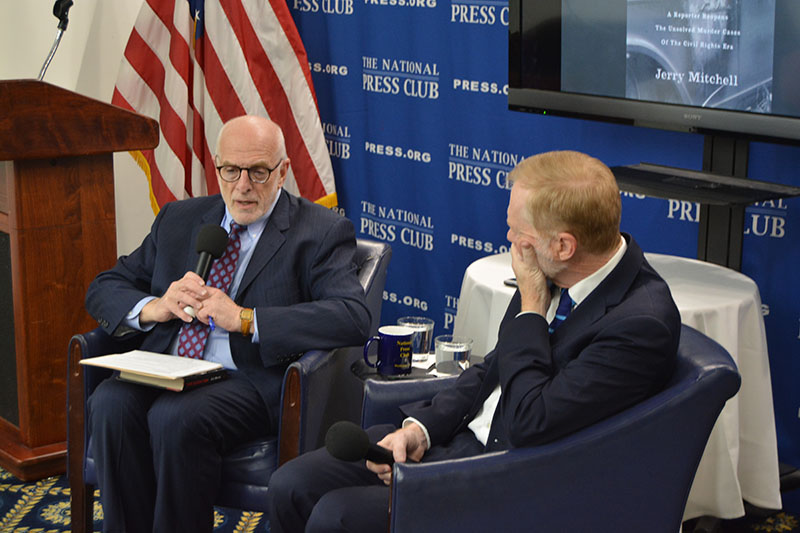Investigative reporter was surprised his article led to reopening of unsolved Medgar Evers murder case

National Press Club President Michael Freedman (left) questions investigative reporter Jerry Mitchell at a Club Headliners Book Event Feb. 19 on Mitchell's Book, "Race Against Time." Photo: Joe Luchok
Investigative reporter Jerry Mitchell, whose article for the Jackson, Miss., Clarion-Ledger in 1989 about the unsolved murder of NAACP leader Medgar Evers 26 years earlier, told a National Press Club audience yesterday that he didn’t think his story would result in a reopening of the case and a solution of the murder.
Speaking at a Headliners Book Event about his book “Race Against Time,” Mitchell explained that soon after his article was published, Jackson police resumed interest in the case. They found a box of evidence from the case and then the gun that led to Byron De La Beckwith, who later was convicted as the murderer.
Mitchell said he interviewed De La Beckwith and found him to be the “craziest person I ever sat down with.” He said Beckwith believed in Christian Identity -- that Adam and Eve were white, that non-white races were created the sixth day with the animals so they have no souls, and that Eve had sex with Satan, which created the Jews. Beckwith was sentenced to life in prison.
After describing his involvement in the Evers case, Mitchell recognized Dorie Ladner, who knew Evers, in the audience.
Mitchell’s book, “Race Against Time,” chronicles four cold murder cases from the civil rights era. Others, besides the Evers case, are the firebombing of Vernon Dahmer, the 16th Street Church bombing in Birmingham and the murder of three civil rights workers in what is known as the Mississippi Burning case.
Asked by the Book Event’s moderator, National Press Club President Michael Freedman, whether he felt pressure over reopening the cases, Mitchell said there was some pressure, as well as some death threats. He said he has not received any blowback on the book.
The discussion shifted to the Sovereignty Commissions that were common in the era. Mitchell said these units were operated by southern states to protect them from federal intrusion trying to change their way of life. He said the commissions had two arms, a propaganda arm and a spy arm. The propaganda arm would send whites and blacks North to talk how well segregation worked. The spy arm would infiltrate civil rights organizations. Commissions in various states worked together, he said.
Asked what led him to become an investigative reporter, Mitchell said a friend recommended that he should read “All the President's Men,” by Washington Post Watergate reporters Bob Woodward and Carl Bernstein. That book showed him, he said, what a reporter could do. “Shoe leather journalism is a pretty good tool,” he said.
As the discussion closed Mitchell said he sees his book as a “love letter to our profession."
